Web Scraping vs Data Mining - Which Method is The Best to Get Smarter Retail Insights?
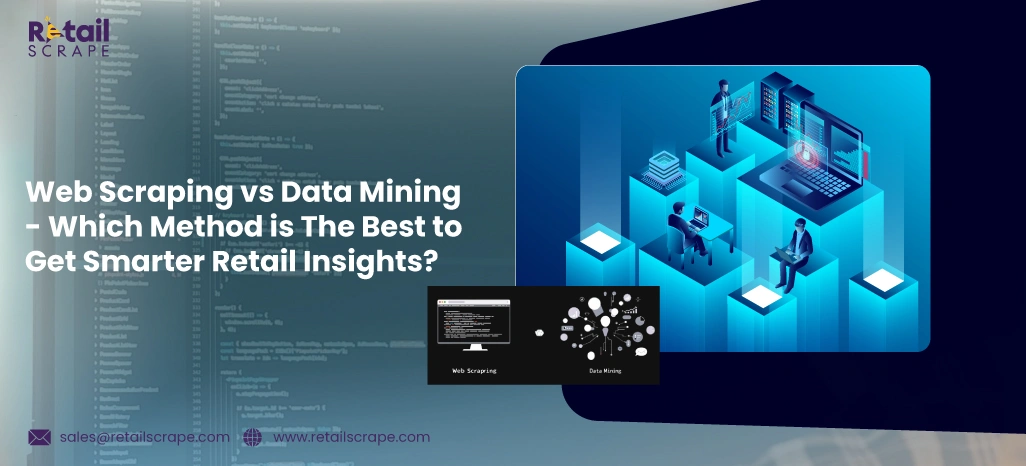
Introduction
In today’s data-driven retail landscape, businesses depend on intelligent techniques to gather and analyze critical information. Web Scraping Services are widely used to extract real-time data from websites like e-commerce platforms, competitor pages, and review sites. On the other hand, data mining involves analyzing existing datasets to uncover patterns, trends, and meaningful correlations—each method serving a unique purpose in driving strategic decisions.
Together, they play complementary roles in shaping retail strategies. The discussion around Web Scraping vs Data Mining is not just about comparing tools—it's about aligning the proper technique with your business objective. Web scraping is ideal for capturing external data quickly and efficiently, whereas data mining thrives on turning internal, structured data into predictive insights.
Understanding the Core: What Do These Techniques Do?
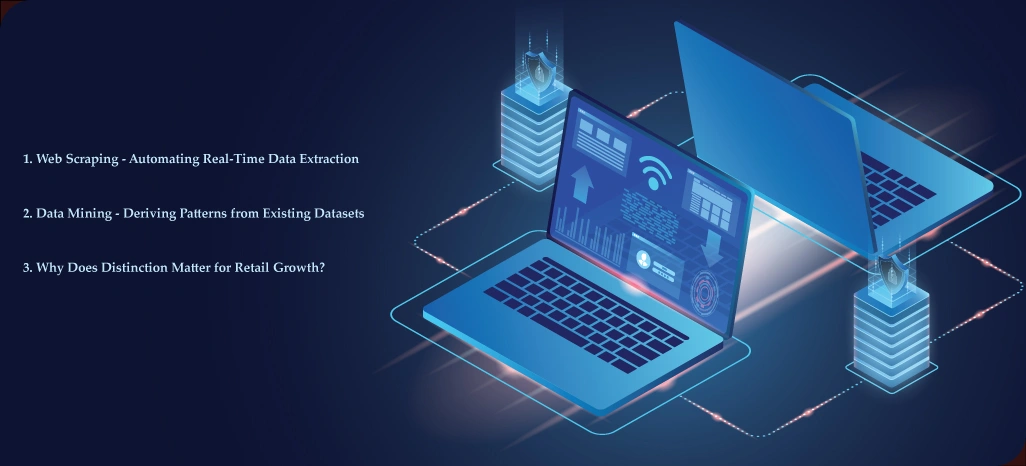
To determine which method delivers greater strategic value, it's essential to understand the core purpose and functionality of each. Both play a vital role in shaping a data-driven retail strategy, but Web Scraping vs Data Mining For Market Insights highlights how they fulfill distinct objectives.
1. Web Scraping - Automating Real-Time Data Extraction
Web scraping is the automated process of collecting structured data from online sources like e-commerce product listings, competitor websites, pricing engines, and customer reviews. By leveraging bots, scripts, or specialized tools, businesses can extract valuable insights, especially for Customer Sentiment Analysis and other data-driven strategies.
- Monitoring dynamic pricing models.
- Tracking competitor assortments.
- Aggregating customer sentiment from review platforms.
- Keeping up with promotional changes and availability.
2. Data Mining - Deriving Patterns from Existing Datasets
In contrast, data mining is the process of uncovering meaningful patterns, correlations, or trends from large volumes of data that are already available, typically in structured formats such as databases or spreadsheets. Rather than gathering new data, it focuses on analyzing existing information using statistical models, machine learning algorithms, and AI techniques.
- Forecasting demand and inventory needs.
- Identifying customer buying patterns.
- Segmenting audiences for targeted marketing.
- Uncovering hidden trends in past sales data.
3. Why Does Distinction Matter for Retail Growth?
The distinction between Web Scraping vs Data Mining becomes increasingly significant when retail businesses aim to enhance their strategic planning, pricing decisions, and overall market responsiveness. While web scraping offers fresh, external intelligence in real time, data mining enables retailers to dig deeper into historical or internal datasets to predict future outcomes.
Each technique serves a unique role in the data journey—one gathers, the other interprets. To achieve more brilliant retail insights, combining both methods can often deliver the most robust and actionable intelligence.
Practical Use Cases of both techniques for Retail Success
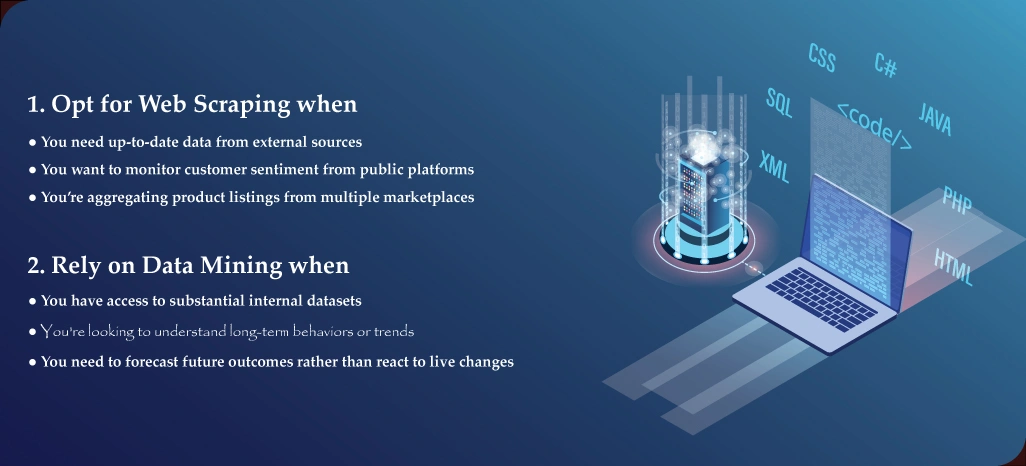
Determining whether to use web scraping or data mining depends on your end goals, the type of data you need, and how fast you need it. Each method serves distinct purposes in retail and excels in different stages of your data strategy.
1. Opt for Web Scraping when
- You need up-to-date data from external sources
- You want to monitor customer sentiment from public platforms
- You’re aggregating product listings from multiple marketplaces
For tracking competitor pricing, stock levels, or promotions in real time, web scraping is ideal. This is especially useful for price comparison tools or dynamic pricing models.
Gathering data from online reviews, forums, and social media can help uncover consumer attitudes and product feedback that aren't captured through internal datasets.
If you're building a comprehensive product feed or keeping a catalog updated with fresh listings, scraping is a fast and scalable solution.
This approach is particularly valuable in Web Scraping For Retail Insights, where rapid access to external market data enables more responsive decision-making.
2. Rely on Data Mining when
- You have access to substantial internal datasets
- You're looking to understand long-term behaviors or trends
- You need to forecast future outcomes rather than react to live changes
Analyzing your customer, transaction, or CRM data is where data mining excels. It helps uncover patterns hidden within complex data environments.
If your objective is to identify purchasing cycles, customer segments, or loyalty patterns, data mining offers deep analytical capabilities.
For example, Data Mining For Retail Analytics can support sales projections, churn prediction, and seasonal demand planning, informing proactive strategies.
By understanding what each method offers and applying them where they fit best, retail businesses can maximize data-driven outcomes, whether reacting swiftly to market changes or planning with confidence.
Evaluating the Impact: Which Method Delivers Faster ROI?

When it comes to driving decisions in retail, Return on Investment (ROI) remains a decisive factor in choosing between different data strategies. Below is a breakdown of how each method performs in delivering measurable impact:
- Real-Time Access to Insights
Web scraping usually delivers faster, more immediate insights. By extracting live data from digital sources, businesses gain access to real-time trends, pricing changes, or customer sentiment, enabling rapid response and quicker decision-making.
- Uncovering Deeper Patterns
Data mining excels in exploring large volumes of structured datasets to uncover patterns, correlations, and behavioral trends. This makes it an invaluable tool for understanding long-term buying habits, predictive analytics, and customer segmentation.
- Flexible and Scalable Reach
Web scraping solutions are more scalable when it comes to broadening data coverage—whether it's tracking multiple competitors, expanding across markets, or aggregating thousands of product listings from various platforms.
- Fueling Sustainable Strategies
On the other hand, data mining supports sustainable growth initiatives. It plays a key role in building personalization engines, loyalty programs, demand forecasting, and strategic planning by working with historical data patterns.
Ultimately, the key takeaway from the Web Scraping vs Data Mining Comparison lies in aligning your choice with your business objectives. While one method may accelerate short-term wins, the other strengthens long-term planning.
Retailers aiming for well-rounded intelligence should consider combining both—using the speed of web scraping with the depth of data mining—to maximize their data’s ROI potential.
Choosing the Right Method for Smarter Retail Decisions
When evaluating techniques to gain actionable retail insights, the choice between Web Scraping vs Data Mining Benefits depends entirely on your use case. Each method has its strengths, limitations, and ideal application scenarios.
Let’s break down the key decision criteria to help you identify the most effective method for your retail intelligence needs:
| Criteria | Web Scraping | Data Mining |
|---|---|---|
| Data Freshness | Enables access to real-time information from live sources | Typically based on historical data, which may be slightly outdated |
| Data Source | Pulls data from external sources like websites or apps | Uses internal repositories such as CRM systems, POS, or databases |
| Setup Time | Fast deployment with minimal pre-requisites | Requires access to well-structured, pre-existing datasets |
| Customization | Highly flexible – custom logic can be tailored for each need | Limited by how structured and clean the existing data is |
| Ideal Use Case | Best suited for competitive tracking and pricing intelligence | More aligned with customer segmentation and trend analysis |
This Web Scraping and Data Mining Comparison highlights how both strategies play distinct roles—web scraping empowers you with live market visibility. At the same time, data mining helps uncover deep, strategic insights from internal operations.
Selecting the right one hinges on your business objectives, resource availability, and the type of data you aim to leverage.
Real-World Use Cases in Retail: How These Methods Are Applied
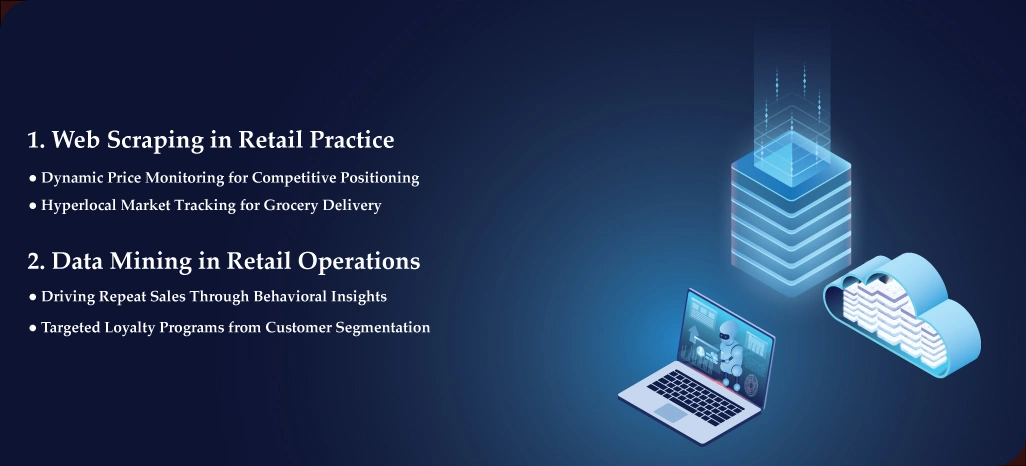
In today’s data-driven landscape, retailers rely on practical analytical approaches to make smarter decisions and stay ahead. By integrating Competitor Analysis, they apply these techniques across real-world scenarios to maintain a competitive edge.
1. Web Scraping in Retail Practice
- Dynamic Price Monitoring for Competitive Positioning
A well-known electronics retailer implements Retail Competitive Intelligence Scraping to track competitor pricing in real-time. This enables agile pricing strategies, especially during high-stakes sales seasons like Black Friday or Diwali, ensuring they never fall behind in value perception.
- Hyperlocal Market Tracking for Grocery Delivery
A rapidly growing grocery delivery platform utilizes Retail Market Research Data Scraping to monitor product availability, pricing trends, and inventory movement across different neighborhoods. This allows them to optimize stocking and pricing strategies tailored to each micro-market they serve.
2. Data Mining in Retail Operations
- Driving Repeat Sales Through Behavioral Insights
A fashion retailer leverages Data Mining For Consumer Behavior Insights by analyzing transactional patterns. By identifying which products lead to repeat purchases, they optimize assortment planning and personalize marketing outreach more effectively.
- Targeted Loyalty Programs from Customer Segmentation
A prominent beauty brand applies Data Mining For Retail Analytics on their historical sales database. Through customer clustering models, they identify high-value segments and craft loyalty campaigns that improve retention and customer lifetime value.
While each method addresses distinct stages—external data collection versus internal data interpretation—their combined use unlocks far greater potential. By integrating both approaches with Price Monitoring, retailers gain the speed, precision, and customer-centric insights needed to drive smarter decisions.
Behind Retail Insights: Tools That Drive Smarter Data Decisions

The power of modern retail data intelligence doesn't just lie in the methodology — it’s heavily influenced by the tools and technology stack that support it. Whether extracting raw information or analyzing trends, the right toolkit can make a significant difference in the speed, accuracy, and depth of insights.
Let’s explore the foundational technologies that power each approach:
1. Key Tools for Web Scraping
- Python Libraries (BeautifulSoup, Scrapy, Selenium)
These are the go-to frameworks for building robust scraping scripts. Each has its strength — from lightweight HTML parsing (BeautifulSoup) to complex crawling (Scrapy) and automated browser interaction (Selenium).
- Proxy Rotation & Anti-Bot Solutions
To ensure uninterrupted access to dynamic or protected sites, proxy services and CAPTCHA-solving tools are used to mimic real user behavior and bypass restrictions.
- Cloud-Based Scraping Platforms
These platforms offer scalable infrastructure, custom scraping pipelines, and scheduling capabilities, allowing businesses to automate large-scale data extraction without managing backend systems.
2. Essential Tools for Data Mining
- Machine Learning Platforms (RapidMiner, Weka, Apache Mahout)
These tools provide drag-and-drop environments or programmable interfaces to model, cluster, and classify data — ideal for discovering patterns and predictive modeling.
- Data Analytics Suites (R, Python with pandas or scikit-learn,
Tableau)
Once data is collected, these tools assist in cleaning, analyzing, and visualizing it for actionable insights. Tableau, in particular, excels in interactive dashboards and retail-specific reporting.
- Big Data & Database Technologies (SQL, Hadoop, Spark)
For handling vast datasets, these systems offer both storage and parallel processing capabilities. They ensure data is accessible, queryable, and ready for deeper mining operations.
When used in tandem, the right mix of Web Scraping And Data Mining Tools allows businesses to bridge the gap between raw data collection and predictive insight generation — a critical advantage in today’s competitive retail environment.
How Retail Scrape Can Help You?
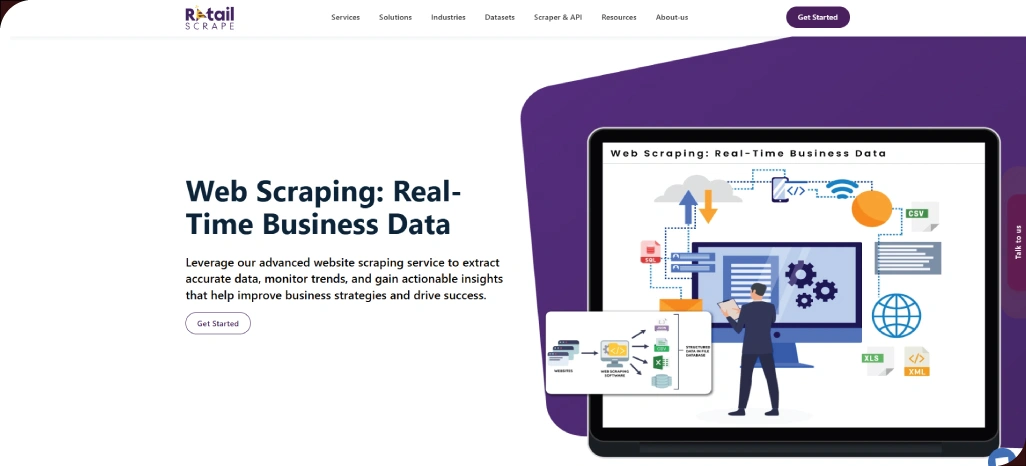
We recognize that the debate around Web Scraping vs Data Mining is more than theoretical— it's a real-world decision that impacts how you gather, analyze, and act on retail data. That’s why we provide specialized solutions tailored to your specific retail intelligence goals.
- Custom retail-focused web scraping workflows.
- Scalable setup for high-volume data collection.
- Delivery-ready data for dashboards and analytics.
- Hybrid integration of scraping with mining techniques.
- Support for structured and unstructured data extraction.
- Fast, reliable access to competitive market signals.
Whether you're tracking live pricing or analyzing historical trends, our solutions are built to deliver real-time accuracy and long-term value. We also help you seamlessly manage your Retail Market Research Data Scraping needs with full compliance and customization.
Conclusion
Choosing between Web Scraping vs Data Mining depends on the type of insights your retail business needs. While scraping offers real-time competitive data, mining helps uncover deeper patterns from existing datasets. Both can work together to create a complete retail intelligence framework.
If you're looking to strengthen your strategy through efficient Web Scraping and Data Mining Comparison, Retail Scrape is here to help. Contact Retail Scrape today to discuss your goals, request a free consultation, or explore a custom data solution tailored to your business.


